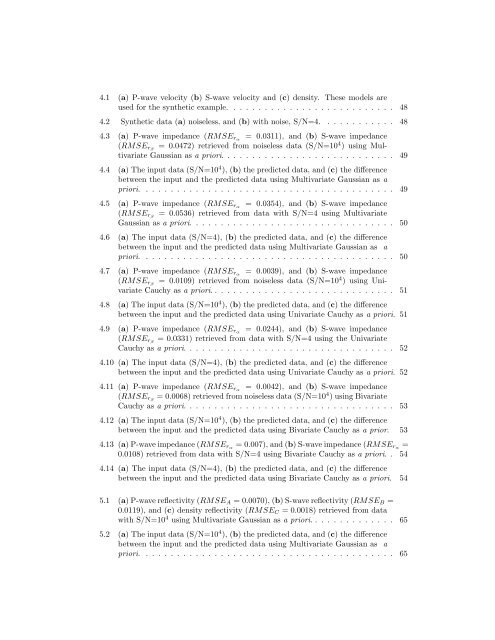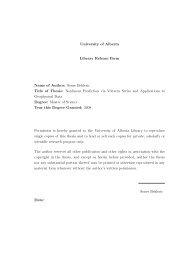Regularization of the AVO inverse problem by means of a ...
Regularization of the AVO inverse problem by means of a ...
Regularization of the AVO inverse problem by means of a ...
You also want an ePaper? Increase the reach of your titles
YUMPU automatically turns print PDFs into web optimized ePapers that Google loves.
4.1 (a) P-wave velocity (b) S-wave velocity and (c) density. These models are<br />
used for <strong>the</strong> syn<strong>the</strong>tic example. . . . . . . . . . . . . . . . . . . . . . . . . . . 48<br />
4.2 Syn<strong>the</strong>tic data (a) noiseless, and (b) with noise, S/N=4. . . . . . . . . . . . 48<br />
4.3 (a) P-wave impedance (RMSErα = 0.0311), and (b) S-wave impedance<br />
(RMSErβ = 0.0472) retrieved from noiseless data (S/N=104 ) using Multivariate<br />
Gaussian as a priori. . . . . . . . . . . . . . . . . . . . . . . . . . . . 49<br />
4.4 (a) The input data (S/N=10 4 ), (b) <strong>the</strong> predicted data, and (c) <strong>the</strong> difference<br />
between <strong>the</strong> input and <strong>the</strong> predicted data using Multivariate Gaussian as a<br />
priori. . . . . . . . . . . . . . . . . . . . . . . . . . . . . . . . . . . . . . . . . 49<br />
4.5 (a) P-wave impedance (RMSErα = 0.0354), and (b) S-wave impedance<br />
(RMSErβ = 0.0536) retrieved from data with S/N=4 using Multivariate<br />
Gaussian as a priori. . . . . . . . . . . . . . . . . . . . . . . . . . . . . . . . . 50<br />
4.6 (a) The input data (S/N=4), (b) <strong>the</strong> predicted data, and (c) <strong>the</strong> difference<br />
between <strong>the</strong> input and <strong>the</strong> predicted data using Multivariate Gaussian as a<br />
priori. . . . . . . . . . . . . . . . . . . . . . . . . . . . . . . . . . . . . . . . . 50<br />
4.7 (a) P-wave impedance (RMSErα = 0.0039), and (b) S-wave impedance<br />
(RMSErβ = 0.0109) retrieved from noiseless data (S/N=104 ) using Univariate<br />
Cauchy as a priori. . . . . . . . . . . . . . . . . . . . . . . . . . . . . . 51<br />
4.8 (a) The input data (S/N=10 4 ), (b) <strong>the</strong> predicted data, and (c) <strong>the</strong> difference<br />
between <strong>the</strong> input and <strong>the</strong> predicted data using Univariate Cauchy as a priori. 51<br />
4.9 (a) P-wave impedance (RMSErα = 0.0244), and (b) S-wave impedance<br />
(RMSErβ = 0.0331) retrieved from data with S/N=4 using <strong>the</strong> Univariate<br />
Cauchy as a priori. . . . . . . . . . . . . . . . . . . . . . . . . . . . . . . . . . 52<br />
4.10 (a) The input data (S/N=4), (b) <strong>the</strong> predicted data, and (c) <strong>the</strong> difference<br />
between <strong>the</strong> input and <strong>the</strong> predicted data using Univariate Cauchy as a priori. 52<br />
4.11 (a) P-wave impedance (RMSErα = 0.0042), and (b) S-wave impedance<br />
(RMSErβ = 0.0068) retrieved from noiseless data (S/N=104 ) using Bivariate<br />
Cauchy as a priori. . . . . . . . . . . . . . . . . . . . . . . . . . . . . . . . . . 53<br />
4.12 (a) The input data (S/N=10 4 ), (b) <strong>the</strong> predicted data, and (c) <strong>the</strong> difference<br />
between <strong>the</strong> input and <strong>the</strong> predicted data using Bivariate Cauchy as a prior. 53<br />
4.13 (a) P-wave impedance (RMSErα = 0.007), and (b) S-wave impedance (RMSErα =<br />
0.0108) retrieved from data with S/N=4 using Bivariate Cauchy as a priori. . 54<br />
4.14 (a) The input data (S/N=4), (b) <strong>the</strong> predicted data, and (c) <strong>the</strong> difference<br />
between <strong>the</strong> input and <strong>the</strong> predicted data using Bivariate Cauchy as a priori. 54<br />
5.1 (a) P-wave reflectivity (RMSEA = 0.0070), (b) S-wave reflectivity (RMSEB =<br />
0.0119), and (c) density reflectivity (RMSEC = 0.0018) retrieved from data<br />
with S/N=10 4 using Multivariate Gaussian as a priori. . . . . . . . . . . . . . 65<br />
5.2 (a) The input data (S/N=10 4 ), (b) <strong>the</strong> predicted data, and (c) <strong>the</strong> difference<br />
between <strong>the</strong> input and <strong>the</strong> predicted data using Multivariate Gaussian as a<br />
priori. . . . . . . . . . . . . . . . . . . . . . . . . . . . . . . . . . . . . . . . . 65









